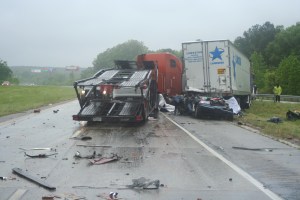Late yesterday afternoon, I heard the news that another man has lost his life when his Tesla went under the side of a tractor trailer in Florida. No matter how it actually came about, doesn’t it seem tragic that we didn’t learn our lesson from Joshua Brown’s tragic death going under the side of a tractor trailer in a Tesla in May 2016?
Earlier today, a Tesla Model 3 owner died in a tragic accident with a semi truck. The Model 3 went under the truck’s trailer resulting “in the roof being sheared off as it passed underneath,” which is known as a “side underride” accident. Tesla Model 3 driver again dies in crash with trailer, Autopilot not yet ruled out
NTSB is sending a team to investigate this crash
Earlier this week, I wrote about the disturbing documentation that current Automatic Emergency Braking (AEB) technology on passenger vehicles is not reliably detecting large trucks: “AEB that reliably detects trucks could prevent underride crashes.” Meanwhile, what should we do? Yet, many of the voices opposing the STOP Underrides! Bill point to Collision Avoidance technology as the better route to prevent underride crashes.
Clearly, collision avoidance technology is not ready to prevent truck underride tragedies at this point in time. In contrast, comprehensive underride protection technology is ready to go — awaiting a mandate to get the ball rolling to save lives.
Here are two practical, viable solutions offered by engineers to prevent the gruesome, deadly passenger compartment intrusion (PCI) which occurs with side underride:
AngelWing side guard successfully tested at the IIHS at 35 and 40 mph in 2017:
We cannot wait for the trucking industry to handle it themselves and the automotive industry is not prepared to prevent collision with large vehicles. Congress should feel proud to be the ones to make sure that this happens. Unless they want people to die!
D. C. Underride Crash Test, March 26, 2019
From the May 2016, Joshua Brown Tesla side underride crash: Witnesses reveal new details behind deadly Tesla accident in Florida
The police report indicated that Brown’s Model S collided with a tractor trailer that was perpendicular to it and continued to travel underneath it after having its windshield and roof sheared off. Because the vehicle was in Autopilot at the time, the vehicle continued to travel before veering off the road, careening through two fences, and finally coming to a rest after striking a utility pole approximately 100 feet south of the road.
Tesla released a statement on their blog:
“What we know is that the vehicle was on a divided highway with Autopilot engaged when a tractor trailer drove across the highway perpendicular to the Model S. Neither Autopilot nor the driver noticed the white side of the tractor trailer against a brightly lit sky, so the brake was not applied. The high ride height of the trailer combined with its positioning across the road and the extremely rare circumstances of the impact caused the Model S to pass under the trailer, with the bottom of the trailer impacting the windshield of the Model S.”
By the way, these are not “extremely rare circumstances.” Hundreds of vehicles collide with the sides of large trucks every year. Furthermore, both of these crashes clearly involved side underride. Why is this not being acknowledged and addressed?







